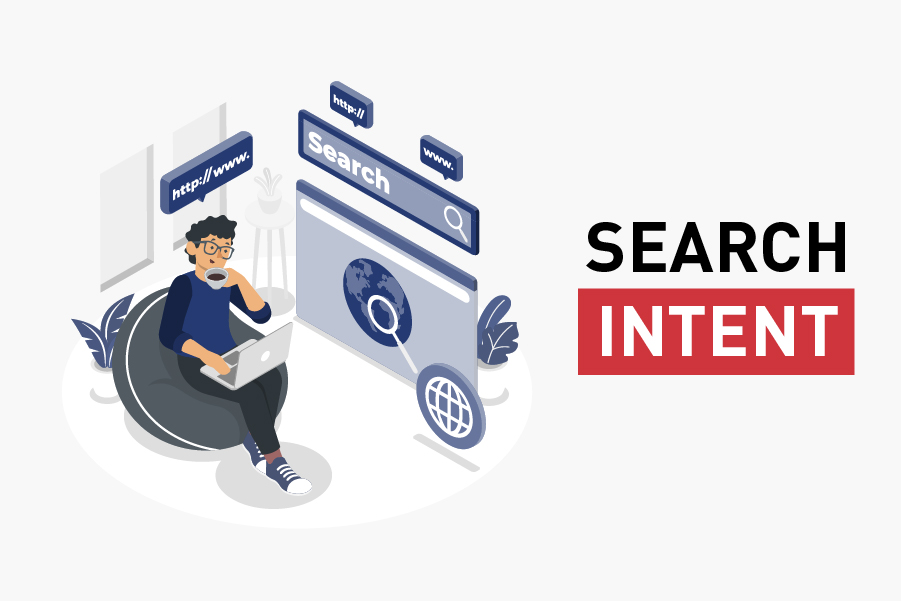It’s challenging to overstate how crucial the idea of search intent is to SEO. I’m not exaggerating when I say that understanding and producing content with search intent in mind is crucial if you want to rank these days.
The purpose of a search query is its search intent. In other words, why did the searcher conduct it? Do they wish to get knowledge? Are they trying to buy something? Or are they trying to find a certain website?
Let’s step into the following guide to learn how it is important for SEO!
Table of Content
- What is Search Intent?
- Why does it matter in SEO?
- The Different Types
- Steps to Determine the Search Intent of a Keyword
- How to use it in organic results?
- Identify search intent from SERPs
- How to use the SERPs in Search Intent?
What is Search Intent?
Search intent, also known as user intent, refers to the reason or purpose behind a user’s search query on a search engine.

It is the primary objective or goal that a user has in mind when performing a search. Understanding user intent is crucial for businesses and website owners as it helps them optimise their website and content to meet the user’s needs and improve their website’s search engine rankings.
Understanding the user intent of your target audience is essential for creating content that meets their needs and solves their problems.
By optimising your content , you can improve your website’s visibility, attract more traffic, and ultimately, achieve your business goals.
Let’s take the example of a business that sells organic beauty products. Here are some examples of search queries and their corresponding user intent:
- “Best organic shampoo for dry hair” – To analyze search intent for this query is a commercial investigation. The user is looking for information on the best organic shampoo for dry hair and is likely to make a purchase in the near future.
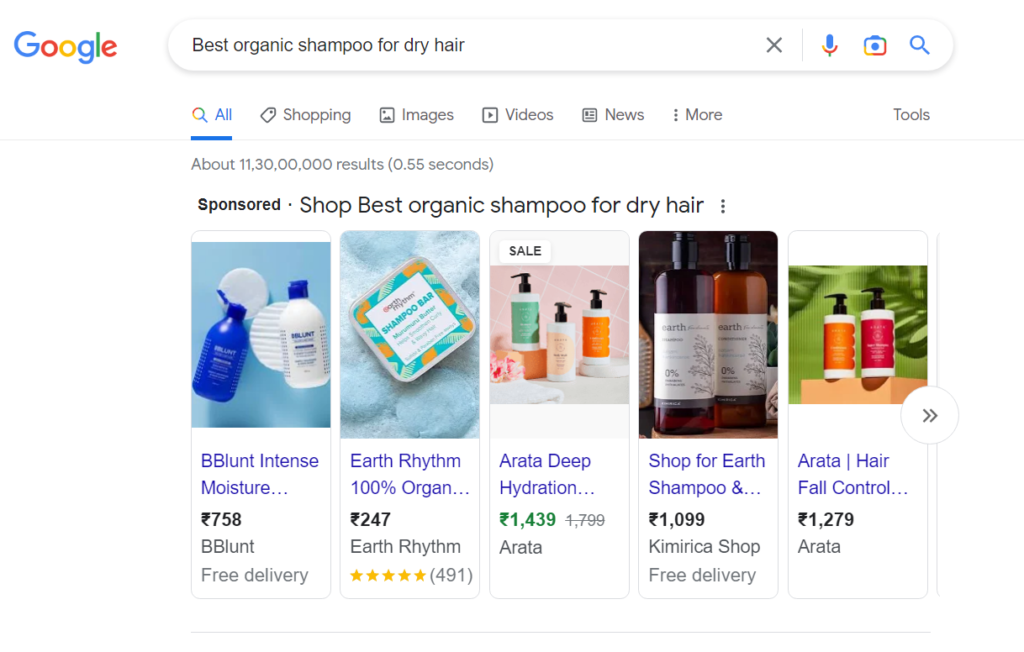
By determining the search intent behind these queries, the business can optimize content for search intent to meet the user’s needs.
For example, they could create blog posts or videos that provide information on how to make organic lip balm at home, or optimize their product pages to rank for the search query “buy organic face cream online”.
By providing relevant and useful content that matches the user’s search intent, the business can attract more traffic and increase its chances of conversion.
Why does it matter in SEO?
Analysing search intent SEO matters because it helps businesses and website owners understand what their target audience is looking for when they perform a query on a search engine.
By understanding the user’s intent, businesses can optimize their website and content to meet their needs and provide them with relevant information, products, or services. Here are some of the key reasons why searcher intent is important:
- Improved user experience – By understanding the user’s intent seo, businesses can create content that matches their needs, which can improve the user experience. Users are more likely to stay on a website and engage with its content if they find what they are looking for quickly and easily.
- Higher search engine rankings – Search engines like Google aim to provide users with the most relevant and useful results based on their search intent. By optimizing your website and content for the user’s intent, you can improve your website’s search engine rankings, which can lead to more organic traffic.
- Increased conversions – By matching the user’s intent in seo, businesses can provide them with the information, products, or services they are looking for, which can lead to increased conversions. Users are more likely to convert if they find what they need quickly and easily.
- Competitive advantage – By understanding the user search intent better than your competitors, you can create more relevant and useful content, which can give you a competitive advantage. By meeting the user’s needs better than your competitors, you can attract more traffic and achieve your business goals more effectively.
It is a critical factor in SEO because search engines like Google prioritize delivering the most relevant results to users based on their search intent.
When users enter a query, they have a specific intention or goal in mind, and search engines aim to provide the most useful results that match their intent.
Therefore, if your website content matches the user’s intent, it is more likely to rank higher in the search engine results pages (SERPs).
In other words, if you optimize your website and content for the user’s intent, you can improve your website’s visibility, attract more traffic, and increase your chances of conversion. Here are some key reasons why it matters in SEO:
Higher click-through rates (CTR):
If your website appears at the top of the search results for a query that matches the user’s intent, it is more likely to attract clicks, which can increase your CTR.
Better user experience:
If your website content matches the user’s intent, they are more likely to find what they’re looking for and have a positive experience on your website. This can lead to increased engagement, longer session durations, and better user signals, which can improve your website’s rankings.
Increased conversions:
If your website content matches the user’s search intent, they are more likely to convert, whether it’s making a purchase, filling out a form, or subscribing to a newsletter.
Competitive advantage:
By understanding the search intent of your target audience and creating content that matches their needs better than your competitors, you can gain a competitive advantage in your industry.
It matters in SEO because it helps you create content that matches the user’s needs, which can lead to higher rankings, more traffic, and increased conversions.
By optimising your website and content, you can improve your website’s performance and achieve your business goals.
The Different Types
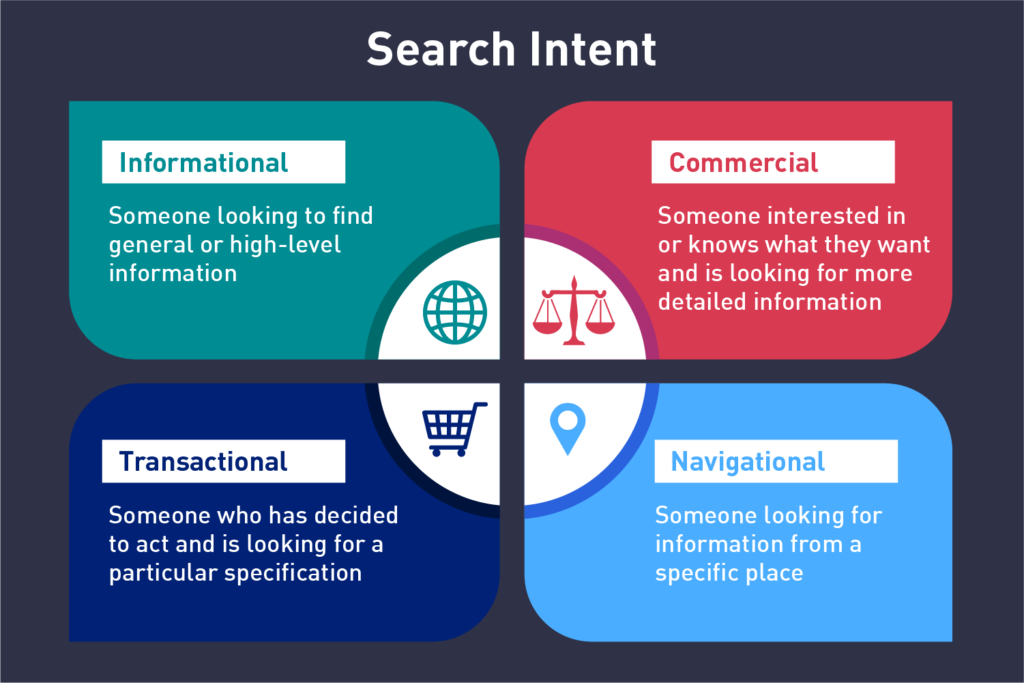
There are four main types of search intent that users typically have when they perform a search query on a search engine. These are:
Informational Intent
This type is when a user is looking for information on a specific topic or question. They may be looking for definitions, instructions, or answers to their queries.
Example queries for informational intent include “How to bake a cake,” “What is the capital of France,” or “Who is the current president of the United States?”
Navigational Intent
This type is when a user is looking for a specific website or webpage. They may already know the name of the website or webpage they want to visit, but are using the search engine to navigate to it more easily. Example queries for navigational intent include “Facebook login,” “YouTube homepage,” or “Amazon Prime login.”
Commercial Investigation Intent
Here when a user is researching a product or service with the intent to make a purchase. They are looking for information on different options and comparing prices, features, and reviews.
Example queries for commercial investigation intent include “best organic shampoo for dry hair,” “affordable laptops for students,” or “top-rated hotels in New York City.”
Transactional Intent
In this type, the user is ready to make a purchase. They have already researched the product or service and are now looking to buy it. Example queries for transactional intent include “buy organic face cream online,” “discount codes for Nike shoes,” or “book a flight to London.”
Understanding the different types is important for businesses and website owners because it can help them create content that matches the user’s needs and intent. By providing relevant and useful content, businesses can improve their website’s search engine rankings, attract more traffic, and increase conversions.
Steps to Determine the Search Intent of a Keyword

Search intent, also known as user intent or query intent, refers to the purpose behind a user’s search query. Understanding searcher intent is crucial for creating content that satisfies users’ needs and helps to rank higher in search engine results pages (SERPs).
Here are some methods to determine the intent of a keyword:
Step 1: Analyze SERP Results:
- One of the easiest ways to determine it is by analyzing the SERP results for the keyword. Examine the top 10 results, and look for common themes or types of content that appear in the results.
- This can give you a good idea of what searchers are looking for when they use this keyword.
- For example, if you search for the keyword “best-running shoes,” the results may include lists of top-rated shoes, product reviews, and guides on how to choose the best running shoes.
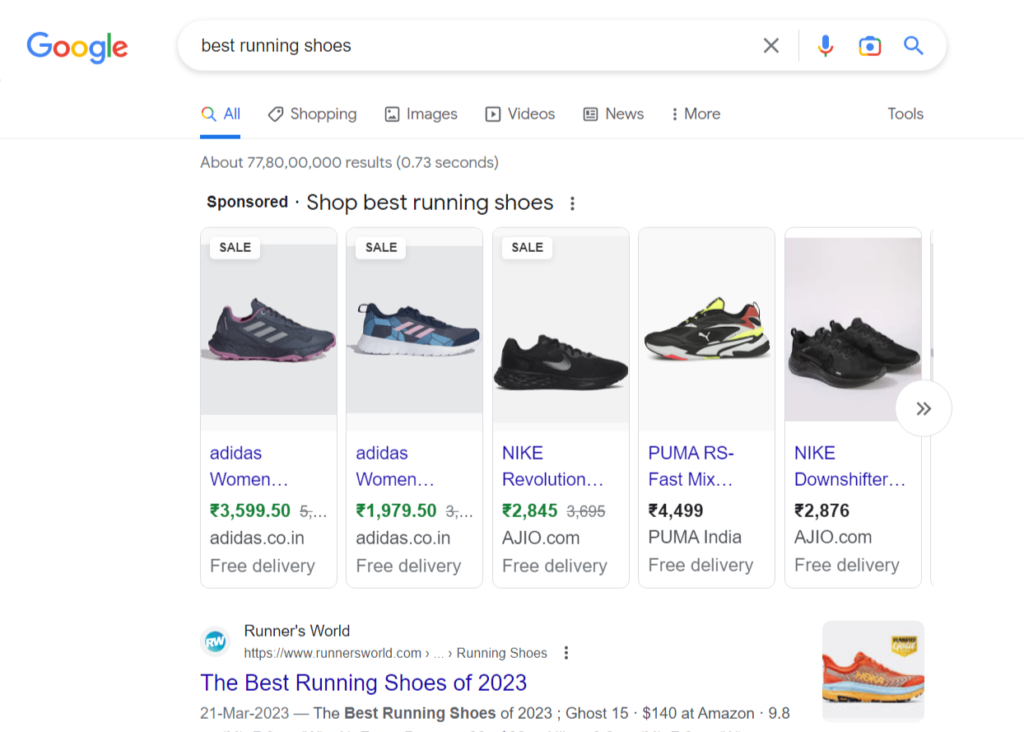
This suggests that the search intent is informational or commercial.
Step 2: Look at Keyword Modifiers:
- Another way to determine searcher intent is by looking at the modifiers used with the keyword. Modifiers are words that provide context and indicate what the user is searching for.
- For example, if the keyword is “buy running shoes,” the search intent is likely transactional. However, if the keyword is “how to choose running shoes,” the search intent is likely informational.
Step 3: Use Google Suggest:
- Google Suggest is a feature that provides suggestions for search queries as you type. By entering the keyword into the search bar and looking at the suggested queries, you can gain insight into what people are searching for when using that keyword.
- This can give you an idea of the different types of search intent associated with the keyword.
Step 4: Utilize Keyword Research Tools:
- Keyword research tools like Ahrefs, SEMRush, or Google Keyword Planner can help to determine keyword search intent.
- These tools often provide data on the types of content that appear in the search results for a given keyword, as well as related keywords and phrases that may indicate search intent.
- By analyzing this data, you can get a better understanding of what people are searching for when they use that keyword.
Step 5: Consider the User’s Stage in the Buying Process:
- Search intent can also be determined by considering the user’s stage in the buying process. For example, if the user is searching for “best running shoes for beginners,” they are likely in the research phase, looking for information to help them make a decision.
- However, if they search for “buy Asics Gel Nimbus,” they are likely ready to make a purchase. Understanding the user’s stage in the buying process can help to create content that aligns with their needs.
Determining search intent is essential for creating content that meets users’ needs and helps to rank higher in SERPs.
By analyzing the SERP results, examining keyword modifiers, using Google Suggest, utilizing keyword research tools, and considering the user’s stage in the buying process, you can gain a better understanding of what people are searching for when they use a particular keyword.
How to Use It in Organic Results?
To use search intent in organic results, you need to first identify the search intent behind the keywords you want to target.
Once you have identified the search intent, you can create content that matches that intent and use the right keywords to optimize your content for search engines. Here are some steps to follow:
1. Identify the intent behind the keyword:
- The first step to using search intent in organic results is to identify the intent behind the keyword. The search intent behind a keyword is what the user is trying to achieve when they enter that keyword into the search engine.
- There are four primary types of search intent: informational, navigational, transactional, and commercial investigation. Once you have identified the search intent behind the keyword, you can tailor your content to match that intent.
2. Create content that matches the intent:
- Once you have identified the search intent behind the keyword, you should create content that matches that intent. For example, if the search intent behind the keyword is informational, you should create content that provides information about the topic.
- On the other hand, if the search intent behind the keyword is transactional, you should create content that encourages users to take action, such as making a purchase or signing up for a service.
3. Use the right keywords:
- It’s important to use the right keywords in your content to match the search intent. For example, if the search intent behind the keyword is “best running shoes,” you should include related keywords such as “reviews,” “top picks,” or “features.” These keywords will help search engines understand the intent behind your content.
4. Optimize your content for user experience:
- Search intent optimization of content for user experience is essential to keep users engaged and improve your search engine ranking. This includes using easy-to-read language, providing helpful images or videos, and structuring your content in a way that is easy to follow.
- The better the user experience, the more likely users are to engage with your content and return to your website in the future.
5. Analyze search results:
- Finally, it’s important to analyze the search results for the keywords you are targeting. Look at the top-ranking pages and analyze their content to see how they match the searcher intent.
- Use this information to improve your own content and increase your chances of ranking well in organic search results.
Using search intent in organic results is about understanding what users are looking for and providing content that matches their intent.
By identifying the search intent behind the keyword, creating content that matches that intent, using the right keywords, optimizing for user experience, and analyzing search results, you can improve your chances of ranking well in organic search results
Identify Search Intent from SERPs
To identify search intent from the SERPs, look for the following signals:
Titles and meta descriptions of the search results:
The title and meta description of the search results can provide valuable information about the content on the page and the user’s search intent.
Featured snippets:
Featured snippets are short snippets of information that appear at the top of the SERP. They provide a quick answer to the user’s query and are often used for informational searches.
Rich snippets
Rich snippets are enhanced search results that provide additional information about the content on the page, such as reviews, ratings, and prices. They are often used for transactional searches.
Advertisements
Ads can also provide insights into the user’s search intent. For example, if there are several ads for a particular product or service, it indicates that there is high commercial intent for that search query.
Search trends and user behaviour
Analyzing search trends and user behaviour can also help to identify search intent. For example, if a particular search query is trending during the holiday season, it could indicate that users are searching for gift ideas, which would have commercial investigation intent.
By understanding the search intent, you can create content that aligns with the user’s needs and provides a better user experience. This, in turn, can lead to higher rankings, increased traffic, and better engagement on your website.
How to use the SERPs in Search Intent?
Search Engine Results Pages (SERPs) are the pages that show up in response to a user’s search query on a search engine like Google. As a digital marketer, you can use SERPs to understand user search intent better. Here’s how:
1. Analyze the SERP Features:
SERP features are non-organic listings that appear on the search results page. These include ads, local packs, featured snippets, image carousels, and more.
By analyzing the SERP features, you can gain insight into what users are looking for and what they find valuable.
For example, if a user searches for “best coffee shops near me,” they may be looking for reviews or recommendations.
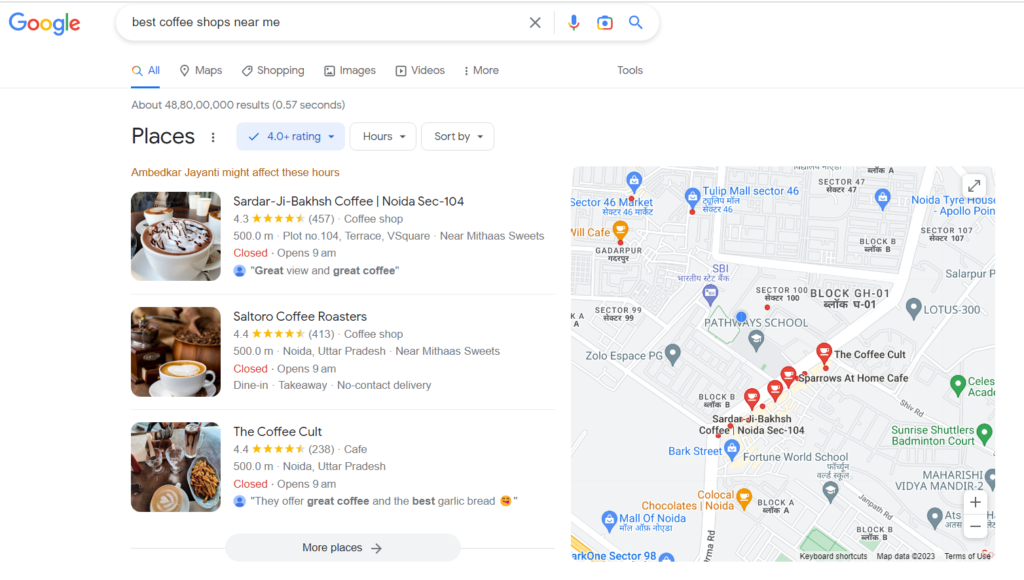
If the SERP shows a local pack with ratings and reviews, it indicates that users value this information.
2. Look at the Search Results:
The search results in themselves can give you insight into user search intent. Look at the titles, descriptions, and URLs of the top-ranking pages. Do they match the user’s search intent?
Are they informative, transactional, or navigational? This will give you an idea of what type of content is resonating with users.
3. Use Keyword Analysis:
Use a tool like Google Keyword Planner to analyze the keywords related to your target search queries. Look for related searches and related queries that appear in the SERP.
This will help you understand what users are searching for and what kind of content they’re looking for.
4. Analyze the Competition:
Look at the competitors ranking for your target keywords. What type of content are they creating? What topics are they covering? This will help you identify gaps in the market and create content that fills those gaps.
5. Monitor Changes:
Keep an eye on changes in the SERP. Google is constantly updating its algorithms and adding new features. By staying up to date, you can adjust your strategy accordingly and stay ahead of the competition.
SERPs provide valuable information about user search intent. By analysing SERP features, search results, keywords, competition, and changes, you can create content that resonates with your target audience and improves your search rankings.
In conclusion, search intent is a critical aspect of SEO as it determines the user’s intention behind their search query, which helps search engines provide the most relevant and useful results.
Understanding search intent allows businesses to optimize their website content and other online marketing efforts to align with the needs and preferences of their target audience, leading to higher engagement, conversions, and customer satisfaction.
By considering search intent in their SEO strategies, businesses can create content that addresses the user’s needs, questions, and pain points, which ultimately improves their online visibility, reputation, and revenue. Therefore, search intent should be a primary consideration for any business looking to improve its SEO performance and drive organic traffic to its website.
